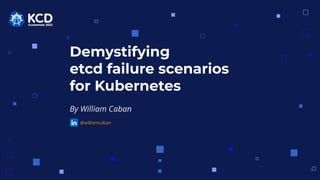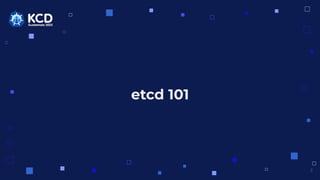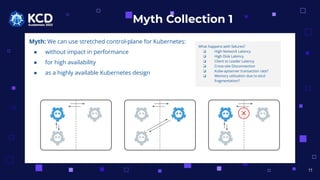[KCD GT 2023] Demystifying etcd failure scenarios for Kubernetes.pdf
- 1. Demystifying etcd failure scenarios for Kubernetes By William Caban 1 @williamcaban
- 2. etcd 101 2
- 3. Kubernetes Control-Plane & etcd 3 W W S S S W S W S W S W Multi Node Cluster Compact Cluster S W All-in-One K8s W W W Multi Node Cluster S W S W S W kube-apiserver kube-scheduler kube-controller-manager cloud-controller-manager container runtime kubelet Kubernetes Architectures A B C D K8s Control Plane (Supervisor role)
- 4. 4 Etcd Redundancy vs Performance Failure Tolerance x 2 x 1 x 0 x 0 Write Performance High Low Required Active Quorum Size Low High Redundancy Low High 3 2 2 1
- 5. 5 The life of a write on etcd 1. No leader 2. The election & vote 3. Leader coordinate the writes 4. For ¡°Set Foo=bar¡±. Leader writes into log entry Foo=bar 5. Replicate ¡°Foo=bar¡± to follower nodes Foo=bar Foo=bar Foo=bar 6. Leader waits for majority to write the entry to commit Foo=bar Foo=bar Foo=bar 7. Leader noti?es followers entry is committed Foo=bar Foo=bar Foo=bar 8. Leader send regular role noti?cations to followers Foo=bar Foo=bar Foo=bar
- 6. Writing to etcd via a Leader (etcd client) A C (Follower) (Leader) (write ¡°foo¡±) B(Follower) 1 Wait while I work¡ 2 Write to my Raft log Send to Followers 4 3 Write to my Raft log Send acknowledgement 6 7 Write to my Raft log Send acknowledgement 6 7 Wait for ack Ack to client 8 5 Send acknowledgement to client and close session 6 (write ¡°foo=bar¡±) 9
- 7. Writing to etcd via a Follower (etcd client) A C (Follower) (Leader) (write ¡°foo=bar¡±) I¡¯m not the leader. Let me forward that to ¡°C¡±. B (Follower) 1 7 (proxied write requests) 7 2 3 4 5 6
- 9. 9 ¡ñ Critical etcd timers settings: ¡ð HEARTBEAT_INTERVAL (100ms) ¡ö Frequency with which the Leader will notify Followers that it is still the Leader ¡ð ELECTION_TIMEOUT (1000ms) ¡ö How long a Follower node will wait without hearing a heartbeat before attempting to become Leader itself. Why the Critical ETCD Timers? Best Practices Heartbeat Interval ? < max(RTT) between members ? Too low increase CPU and network usage ? Too high leads to high election timeout ? slower to recover and detect failures Election Timeout ? 10 times the HEARTBEAT_INTERVAL
- 10. Why the Hardware Speci?cations? 10 CPU RAM DISK 2 to 4 cores 8 to 16 cores MINIMUM PRODUCTION 8 GB 16GB to 64GB < 30ms latency < 10ms latency Introducing the Magic Latency Formula for ETCD latency pro?les¡ Effective Latency = Disk Latency + Max(Jitter(Disk Latency)) + Network RTT + Max(Network Jitter) Note: To maintain etcd stability at scale, the E?ective Latency must be well below < Election Timeout
- 11. Myth Collection 1 11 Myth: We can use stretched control-plane for Kubernetes: ¡ñ without impact in performance ¡ñ for high availability ¡ñ as a highly available Kubernetes design What happens with failures? ? High Network Latency ? High Disk Latency ? Client to Leader Latency ? Cross-site Disconnection ? Kube-apiserver transaction rate? ? Memory utilization due to etcd fragmentation?
- 12. Myth Collection 2 12 Myth: We can use backups of etcd to: ¡ñ Restore Kubernetes in case of disaster recovery ¡ñ Rollback Kubernetes ¡ñ To recover the applications running in the cluster What happens with failures? ? Cluster identity? ? Certi?cates? ? ETCD peer certi?cates? ? ETCD identity? ? Persistent storage? ? API Schema Version? Manifest and other K8s objects Container image PersistentVolumeClaim PersistentVolume CSI-enabled storage backend Kubernetes Application Stack (Pods, Manifests, Storage mappings, etc) VS.
- 13. 13 ETCD Failure Modes https://etcd.io/docs/v3.5/op-guide/failures/ Leader failure Follower failure Majority failure Majority failure Network Partition Network Partition
- 14. 14 What to Remember about etcd?
- 15. Enjoy the rest of the event! Image by https://www.opsramp.com/guides/why-kubernetes/who-made-kubernetes/ 15















